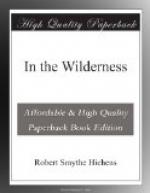There is no conceit, we are apt to say, like that born of isolation from the world, and there are no such conceited people as those who have lived all their lives in the woods. Phelps was, however, unsophisticated in his until the advent of strangers into his life, who brought in literature and various other disturbing influences. I am sorry to say that the effect has been to take off something of the bloom of his simplicity, and to elevate him into an oracle. I suppose this is inevitable as soon as one goes into print; and Phelps has gone into print in the local papers. He has been bitten with the literary “git up.” Justly regarding most of the Adirondack literature as a “perfect fizzle,” he has himself projected a work, and written much on the natural history of his region. Long ago he made a large map of the mountain country; and, until recent surveys, it was the only one that could lay any claim to accuracy. His history is no doubt original in form, and unconventional in expression. Like most of the writers of the seventeenth century, and the court ladies and gentlemen of the eighteenth century, he is an independent speller. Writing of his work on the Adirondacks, he says, “If I should ever live to get this wonderful thing written, I expect it will show one thing, if no more; and that is, that every thing has an opposite. I expect to show in this that literature has an opposite, if I do not show any thing els. We could not enjoy the blessings and happiness of riteousness if we did not know innicuty was in the world: in fact, there would be no riteousness without innicuty.” Writing also of his great enjoyment of being in the woods, especially since he has had the society there of some people he names, he adds, “And since I have Literature, Siance, and Art all spread about on the green moss of the mountain woods or the gravell banks of a cristle stream, it seems like finding roses, honeysuckels, and violets on a crisp brown cliff in December. You know I don’t believe much in the religion of seramony; but any riteous thing that has life and spirit in it is food for me.” I must not neglect to mention an essay, continued in several numbers of his local paper, on “The Growth of the Tree,” in which he demolishes the theory of Mr. Greeley, whom he calls “one of the best vegetable philosophers,” about “growth without seed.” He treats of the office of sap: “All trees have some kind of sap and some kind of operation of sap flowing in their season,” the dissemination of seeds, the processes of growth, the power of healing wounds, the proportion of roots to branches, &c. Speaking of the latter, he says, “I have thought it would be one of the greatest curiosities on earth to see a thrifty growing maple or elm, that had grown on a deep soil interval to be two feet in diameter, to be raised clear into the air with every root and fibre down to the minutest thread, all entirely cleared of soil, so that every particle could be seen in its natural position. I think it would astonish even the wise ones.” From his instinctive sympathy with nature, he often credits vegetable organism with “instinctive judgment.” “Observation teaches us that a tree is given powerful instincts, which would almost appear to amount to judgment in some cases, to provide for its own wants and necessities.”




